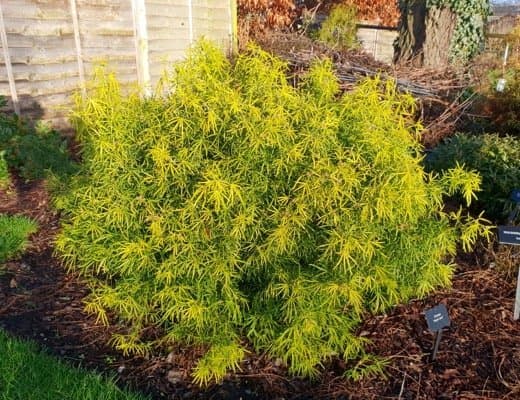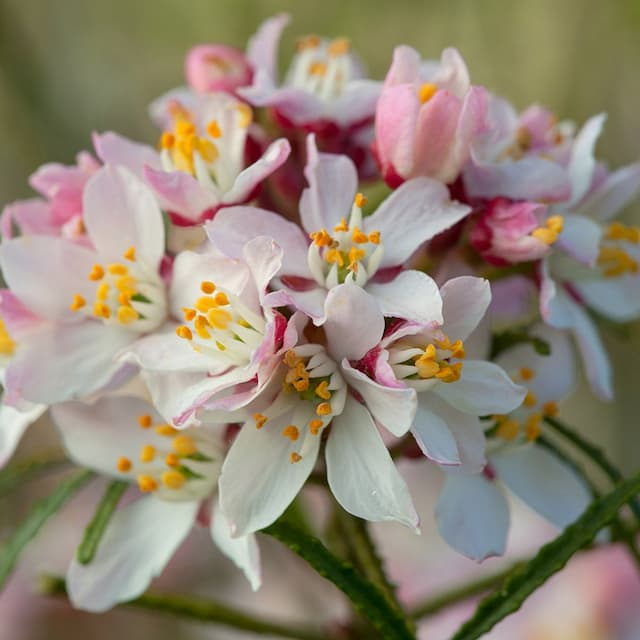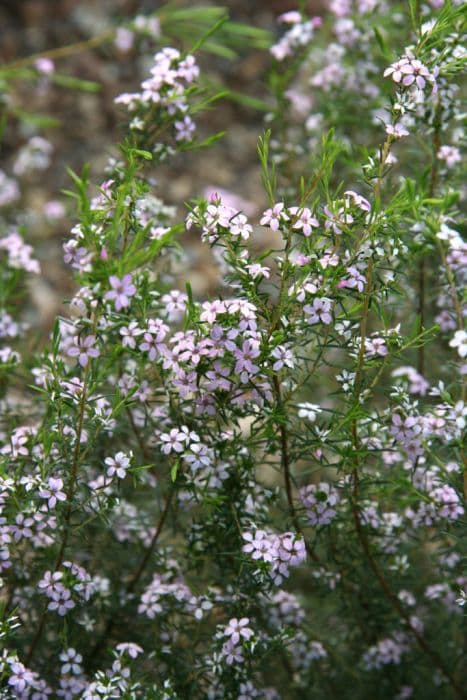Japanese Orixa Orixa japonica

ABOUT
Orixa japonica, commonly known as Japanese orixa, is a deciduous shrub that bears a distinct appearance with its trifoliate leaves. Each leaf generally consists of three broad, ovate leaflets that are bright green and have a glossy texture, giving the foliage a vibrant and lush look. During fall, the leaves transform into striking autumnal colors, turning the shrub into a warm display of yellows and oranges. This plant produces small, inconspicuous flowers that are greenish-white in color, which bloom in clusters. The flowers have an interesting, somewhat spicy fragrance that can catch the attention of passersby. Following flowering, Japanese orixa forms small, black fruits that are quite noticeable against the green of the leaves, although they are not typically considered ornamental. The overall form of Japanese orixa is rounded, with branches that grow in an upward and outward fashion, giving the shrub a somewhat irregular silhouette. Its stems are slender and may bear some thorns that add to the plant's textural quality. In terms of appeal, Japanese orixa is appreciated for its aromatic leaves and its ability to adapt well to various growing conditions, making it a versatile choice for gardeners. The contrasting seasons bring about a dynamic change in the plant's appearance, which can add seasonal interest to a garden setting.
About this plant
 Names
NamesFamily
Rutaceae
Synonyms
Japanese Orixa, Japanese Meadow Parsley
Common names
Orixa japonica Thunb., Choisy, Ruta orixa Siebold, Skimmia orixa Siebold ex Miq., Toddalia orixa Miq.
 Toxicity
ToxicityTo humans
Orixa japonica, commonly known as Japanese orixa, has been recognized as poisonous to humans. When any part of the plant is ingested, the primary toxic principle is believed to be its essential oils, which can lead to symptoms like gastrointestinal upset, including nausea, vomiting, and diarrhea. Ingestion of large quantities could potentially lead to more severe symptoms such as fatigue, confusion, or convulsions, although documented cases of severe poisoning in humans are rare. It is advised to avoid consuming any part of the Japanese orixa and to seek medical attention if ingestion occurs.
To pets
Japanese orixa is considered toxic to pets, just like it is to humans. If pets ingest any part of this plant, they could experience symptoms consistent with plant poisoning, such as vomiting, diarrhea, and possibly more severe reactions with larger doses, like tremors or seizures. It is important to ensure pets do not have access to Japanese orixa and to contact a veterinarian immediately if you suspect your pet has ingested any part of this plant.
 Characteristics
CharacteristicsLife cycle
Perennials
Foliage type
Deciduous
Color of leaves
Green
Flower color
Yellow
Height
6-10 feet (1.8-3 meters)
Spread
6-10 feet (1.8-3 meters)
Plant type
Shrub
Hardiness zones
5
Native area
Japan
Benefits
 General Benefits
General Benefits- Ornamental Value: Japan Arrowwood is often used in landscaping for its attractive glossy green foliage, which adds aesthetic appeal to gardens and parks.
- Wildlife Habitat: The plant provides shelter and breeding sites for various small birds and insects, enhancing biodiversity.
- Low Maintenance: It is known for being hardy and requiring minimal care once established, making it suitable for gardeners at all levels of experience.
- Drought Tolerance: Japan Arrowwood can survive in dry conditions, making it a good choice for regions with water scarcity or for xeriscaping.
- Erosion Control: The root system helps stabilize soil, reducing the risk of erosion on slopes and in areas prone to soil degradation.
- Adaptability: It is capable of growing in a variety of soil types and pH levels, which contributes to its versatility as a garden plant.
- Seasonal Interest: Japan Arrowwood produces small, fragrant flowers and, in some cases, ornamental berries that can add seasonal interest throughout the growing season.
- Privacy Screen: When planted in groups, it can serve as an effective natural privacy screen or windbreak, helping to protect more sensitive plants.
- Shade Provider: As a moderate-sized shrub, it can offer shade to smaller plants and contribute to the layered structure of garden design.
 Medical Properties
Medical Properties- Anti-inflammatory: Traditionally, Orixa japonica has been used to reduce inflammation.
- Antipyretic: The plant may have been used to reduce fever.
- Analgesic: It has been mentioned that Orixa japonica might have properties that help to alleviate pain.
- Antimicrobial: Some parts of the plant are believed to have antimicrobial activity against certain pathogens.
 Air-purifying Qualities
Air-purifying QualitiesThis plant is not specifically known for air purifying qualities.
 Other Uses
Other Uses- Orixa japonica, commonly known as Japanese orixa, can be utilized as a natural dye for fabrics, giving materials a unique and earthy tone.
- The wood of the Japanese orixa is useful for making small handcrafted items, such as utensils or decorative figures, because of its fine grain and workability.
- In landscape design, the plant is often used for creating hedge borders due to its dense foliage and tolerance for pruning.
- Juvenile plants provide excellent ground cover in gardens, filling spaces effectively with their lush green leaves.
- Japanese orixa is also employed in bonsai culture because of its attractive leaf shape and adaptability to shaping and training.
- The plant's branches are sometimes used in floral arrangements to add complexity and a touch of greenery due to their shape and leaf density.
- Its resistance to pests and diseases makes it a useful companion plant in gardens to promote the health of more susceptible plants.
- The subtle fragrance of the Japanese orixa leaves can be encapsulated into potpourri mixes to naturally freshen up indoor spaces.
- In educational settings, Japanese orixa can be used as a tool for teaching plant biology and horticulture due to its distinct characteristics and growth patterns.
- Jams and preserves manufacturers occasionally infuse the mild herbaceous flavor of Japanese orixa leaves into their products for an exotic twist.
Interesting Facts
 Feng Shui
Feng ShuiThe Japanese orixa is not used in Feng Shui practice.
 Zodiac Sign Compitability
Zodiac Sign CompitabilityThe Japanese orixa is not used in astrology practice.
 Plant Symbolism
Plant Symbolism- Resilience: Orixa japonica, commonly known as Japanese meadowweet, can grow in a variety of soil conditions and demonstrates strength in adversity, symbolizing resilience in the face of challenges.
- Purification: The plant is believed to have purifying properties in traditional practices, representing the cleansing of negative energy or impurities.
- Protection: In some cultures, plants resembling the Orixa japonica may be used in rituals to ward off evil spirits or provide protection from harm.
 Water
WaterThe Japanese orixa prefers consistent moisture and should be watered deeply once every week, especially during dry spells. Ensure the plant receives about 1 gallon of water at each watering session to keep the soil evenly moist but not waterlogged. During the winter months, reduce watering to every other week, providing half a gallon as the plant's growth slows down. Always check the top inch of the soil before watering; if it feels dry to the touch, it’s time to water the plant.
 Light
LightThe Japanese orixa thrives in partial shade to full sun conditions. It can tolerate direct sunlight but will do best when provided with some afternoon shade, especially in hotter climates. The ideal spot is one where the plant can receive morning sunlight and be protected from the harsher afternoon sun, which can help prevent leaf scorch.
 Temperature
TemperatureThe Japanese orixa generally prefers temperate conditions and can survive in temperatures ranging from 20°F to 100°F. The ideal temperature for this plant is between 60°F and 80°F. It's hardy and can tolerate occasional dips below 20°F for short periods, but prolonged exposure to extreme cold can be damaging to the plant.
 Pruning
PruningPruning the Japanese orixa is necessary to maintain its shape and encourage healthy growth. Prune in the late winter or early spring before new growth begins. Remove any dead or damaged branches, and thin out the plant to allow light and air to reach the inner branches. Pruning can also be done after flowering to shape the plant and control its size.
 Cleaning
CleaningAs needed
 Soil
SoilJapanese Alder thrives best in a well-draining soil mix that is rich in organic matter with a pH ranging from slightly acidic to neutral (pH 6.0-7.0). A good recipe for soil would be to mix garden soil with compost and perlite or pumice for improved drainage.
 Repotting
RepottingJapanese Alder should be repotted approximately every two to three years. It's best to repot in early spring before the onset of new growth.
 Humidity & Misting
Humidity & MistingJapanese Alder prefers moderate humidity levels but is quite adaptable to different humidity conditions as long as it is not extremely dry.
 Suitable locations
Suitable locationsIndoor
Place in bright, indirect light and avoid dry air.
Outdoor
Plant in partial shade and shelter from strong winds.
Hardiness zone
6-9 USDA
 Life cycle
Life cycleOrixa japonica, commonly known as Japanese orixa, begins its life cycle as a seed that germinates in spring under appropriate warmth and moisture. Upon germination, it develops a root system and a shoot that grows into a sapling with rudimentary leaves. The sapling gradually matures into a bushy shrub, with branching stems and foliage development occurring over the following years. The plant reaches reproductive maturity and produces clusters of small, fragrant flowers, typically white or off-white, that are pollinated by insects. After pollination, the flowers develop into small, dry fruits containing seeds that, once matured and dispersed, can germinate to start a new life cycle. During its life, the Japanese orixa may undergo periods of dormancy in winter, shedding leaves in colder climates, and resuming growth in the spring.
 Propogation
PropogationPropogation time
Spring-summer
The most popular method of propagating Japanese Orixa or Orixa japonica is through seed. Sowing the seeds should ideally be done in the fall immediately after harvest when they are fresh, as this aligns with the plant's natural germination cycle. To propagate Japanese Orixa from seed, one would collect the ripe fruit, clean the seeds from the pulp, and then sow them directly into a well-drained seed starting mix. Place the seeds just under the surface of the soil, at a depth around 1/4 inch (about 6 millimeters), and keep the soil moist until germination, which may take several weeks. It's important to provide consistent moisture and ensure temperatures are mild, avoiding frost exposure for the young plants. As they grow and become more robust, they can either be transplanted to larger pots or moved to their final position outdoors.









